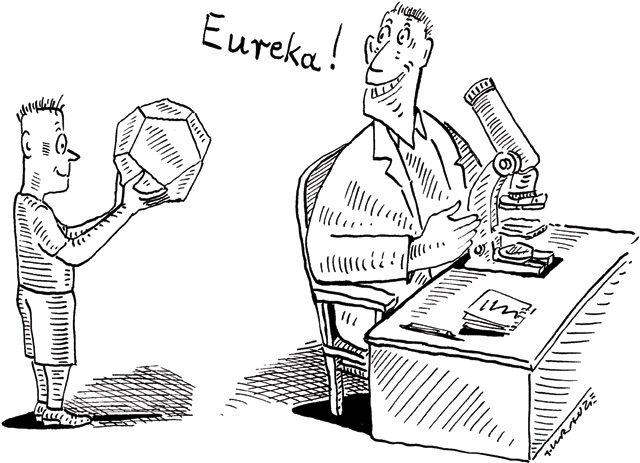Chemist Sven Hovmöller of Stockholm University had been trying for nearly a decade to determine the structures of materials known as quasicrystals and their nearly identical approximants. Thought to be physically impossible until some 30 years ago, quasicrystals are aperiodic structures—meaning they don’t display the rigidly repeating patterns characteristic of crystals like sodium chloride, for example. Since their discovery in the lab, physicists had been working tirelessly to better understand the structure of quasicrystals. But because the existence of such materials was doubted for so long, computer programs currently used to interpret imaging data aren’t equipped to analyze the aperiodic structures.
Hovmöller has worked on and off in the field of quasicrystals for more than 25 years, focusing primarily on the aluminum-cobalt-nickel (Al-Co-Ni) system. Like other quasicrystal researchers, he studied not the elusive materials themselves but their approximants, which differ in atom placement by only 1 or 2 percent and have more tractable patterns of atomic arrangement. Hovmöller’s interest in quasicrystals was piqued when he saw a conference poster displaying an electron microscopy image of one of the Al-Co-Ni approximants. The image was “so beautiful, so clear, [that] it should be possible to solve it,” recalls Hovmöller, who immediately invited Markus Döblinger, the student who made the poster, to do a postdoc in his lab.
But after months of further electron microscopy studies, the duo couldn’t seem to solve the structure. “Not only him and me, but other people also involved, tried so hard, but we didn’t get anywhere,” Hovmöller recalls. “It was extremely annoying."
The image was so beautiful, so clear, that it should be possible to solve it.
—Sven Hovmöller, Stockholm University
Döblinger eventually moved on to the University of Munich, but Hovmöller couldn’t let the idea go. “Every year, once or twice, I [tried] to solve these things, and I just couldn’t.” Then, last summer, he had a seemingly off-the-wall idea. He’d enlist the aid of his 10-year-old son, Linus. “I thought, He’s a smart guy; maybe he could help me,” Hovmöller says.
The father-and-son team sat at the kitchen table for 2 days, poring over the dozens of electron microscopy images Döblinger had generated, as well as some X-ray diffraction data, which provides more precise information on the materials’ atomic positions. Hovmöller would explain to Linus what he was thinking about how the images all fit together, and when Linus didn’t understand something, he’d interrupt his father to ask. This made Hovmöller realize that he was rushing to conclusions. When he slowed down to clear up Linus’s confusion, he’d get new ideas. “In 2 days, we solved four new structures.”
They published their findings in a special issue of Philosophical Transactions of the Royal Society A honoring the 85th birthday of Alan Mackay, who had predicted the existence of quasicrystals before they were identified in 1982. Linus was listed as a coauthor on the paper (370:2949-59, 2012).
“A kid [who] is clever and good at spatial things might well come up with a solution to a problem like that,” says surface physicist Renee Diehl of Penn State University. “I think there’s probably a lot of potential in 10-year-old kids that we’re not tapping.”
And in fact, Linus isn’t as unlikely a character as one might expect in the field of quasicrystals. “There have been a lot of highly creative and unusual people associated with the field,” says Carnegie Mellon University theoretical physicist Mike Widom. Amateur mathematician Robert Ammann, for example, made several significant contributions to quasicrystal theory before the crystals were even proven to exist. Others have pointed to the links between quasicrystals and art, such as aperiodic tilings and mosaics found in Persia. There’s even a company, called Zometool, that manufactures toys used to model quasicrystalline shapes, Widom notes. “The field is quite rich … [in] unusual personalities,” he says. “This boy is in the tradition of the field attracting some nontraditional scientists.”
But all the structures of the Al-Co-Ni quasicrystal and its approximants aren’t exactly solved. “What Sven Hovmöller did is quite nice,” says Walter Steurer of the Laboratory of Crystallography at ETH Zurich, but his methods are qualitative. Thus, Hovmöller and Linus merely mapped out some of the repeating motifs in four of the approximant structures, but “did not publish any atomic coordinates.” The precise locations of some of the crystals’ atoms have yet to be pinpointed.
“A lot of the interesting controversy in the field of quasicrystals has to do with fairly fine details,” which are critically important to understanding the materials’ true structures, Widom says. “You can know where 90 percent of the atoms are, but still not really know the structure because a minority of the atoms are doing interesting and crucial things. . . . What [Hovmöller and Linus] give us is a good starting point for future structure refinement.”
But if someone eventually solves the true structure of the Al-Co-Ni quasicrystal or its approximants, it won’t be Linus. “He’s refused” to work on the remaining structures, Hovmöller says with a laugh. “He’s still a little bit tired” from the last bout of structure solving.

Sem comentários:
Enviar um comentário